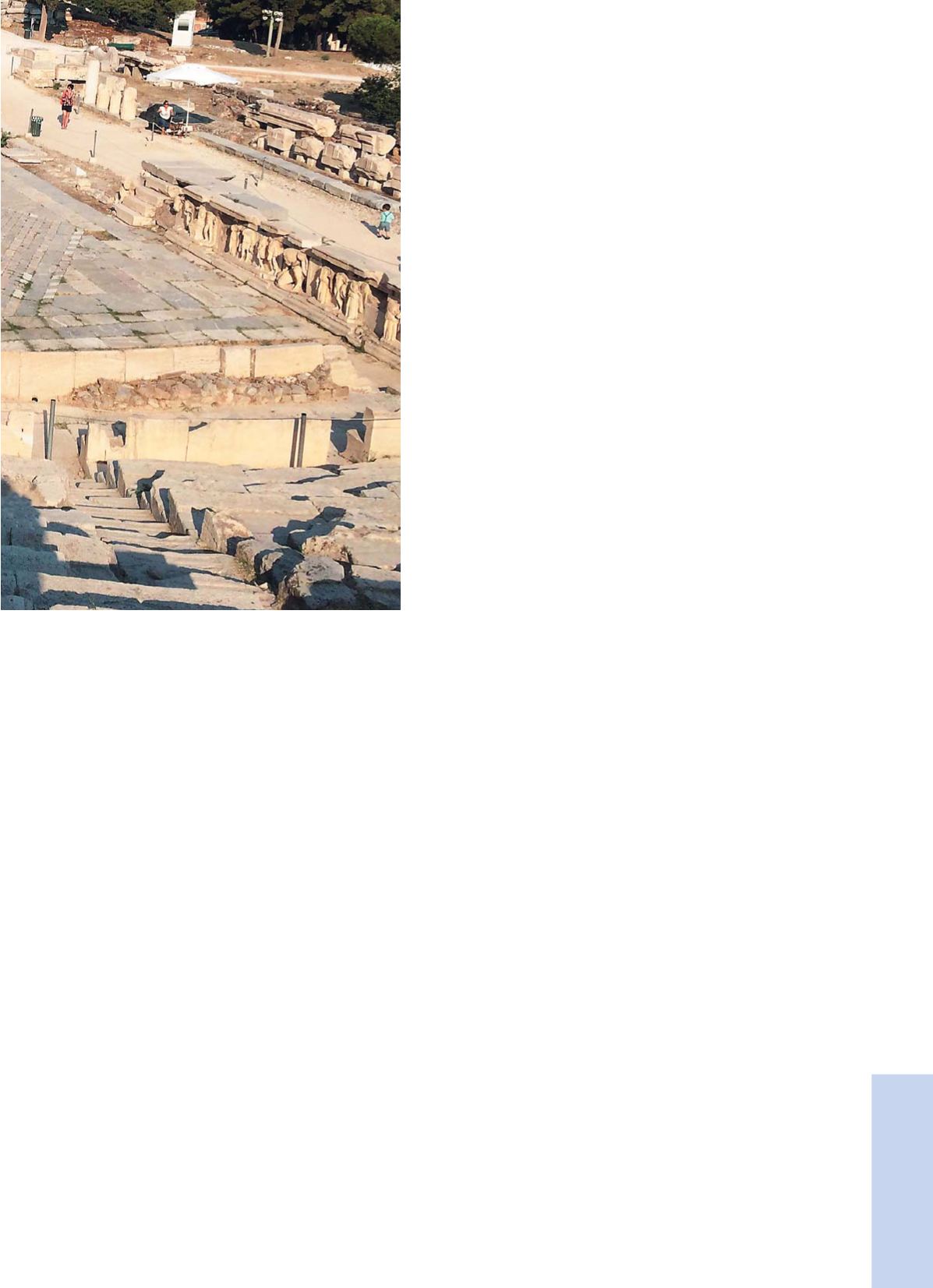
were placed and at whose centre a kind of altar,
the “
thymeli
”, was built; and
• the “
koilon
”, the reclining part of the theatre,
were the viewers’ benches were situated.
Later on, theatre architecture was enriched through
the addition of the “
skene
” —a single or two-storey
structure— that acted as a backdrop and resonator
for the actors, as well as a backstage area for
changing costumes and setting up various theatri-
cal “machines”, the most important being the one
that made it possible for gods to descend from the
heavens (
deus ex machina
) in order to resolve
unsolvable problems in the plot of the play. The side
of the scene facing the audience usually depicted
the facade of a temple or a palace, with three
entrances, the middle of which was used for the
king’s exit.
In Greek antiquity, theatre was identified with the
concept of culture, and cities without theatres were
treated by their neighbours with great scepticism
and disdain.
Ancient Greeks founded dozens of theatres
throughout the then known world; even Spartans,
whom we have come to view as solely interested in
exercising and fighting, had their own theatre.
Apart from Athens, there were also important the-
atres in Eleusis, Argos, Epidaurus, Delphi, Delos,
Eretria, Milos, Messene, Megalopolis, Egira,
Sikyona, Dodoni, Larissa, Dion, Thassos, as well as
Knossos and Festus in Crete.
Some of the best preserved ancient theatres are
the following:
a) Theatre of Dionysus
The most ancient surviving Greek theatre is located
in Athens, on the south side of the Acropolis, within
the area dedicated to the worship of the god
Dionysus. The history of the Dionysian theatre
begins after 500 BC, when the archaic temple of
Dionysus was built on this site and the god’s festi-
vals were transferred there from the Agora, where
they were originally held. A little to the north from
that temple, on the slope of the Acropolis and
almost three metres higher, lies a flat circular area,
where the festivals in honour of the god were held.
This was the site of the Great Dionysia, the most
glorious festival held by Athenians in honour of the
god, which was celebrated each year, during the
month Elaphebolion (late March to early April).
This circular area, formed of hard-pressed earth,
was almost 25 metres in diameter and constituted
the original
orchestra
of the theatre that would be
built later on, around which wooden benches were
placed for the audience.
The circular dithyrambic dance of Dionysus wor-
shipers performed in this area gave birth to tragedy,
while the celebrations in honour of the god gave
their place to “dramatic contests”, also directly
linked to Dionysus worship.
This is where plays by the great Athenian tragedi-
ans Aeschylus, Sophocles, and Euripides, as well
as comedies by Aristophanes, Menander etc. were
staged for the very first time.
Later on, at the time of orator and statesman
Lycurgus (ca. 330 BC), the spectators’ wooden
benches were completely replaced by stone seats
—the remnants of which can still be seen today—
stretching up to the foot of the Sacred Rock of the
Acropolis, while a wooden building, the
skene
, was
attached to the orchestra. It is estimated that these
new structures brought the capacity of the theatre
of Dionysus to 15-16 thousand spectators.
It should be stressed that performances in the the-
atre of Dionysus were attended by thousands of
Athenian citizens, as well as metics and foreigners;
in fact, the state provided destitute citizens with an
allowance that enabled them to attend the dramat-
ic plays, which were considered to be lessons in
culture and democracy.
The first row of seats comprised 67 marble thrones,
each inscribed with the name of the dignitary that
occupied it. At the centre of the row stood the throne
of the priest of Dionysus. The
skene
was most like-
ly a rectangular structure, stretching along the
orchestra, with projecting wings at both ends, the
Trade with Greece
115


